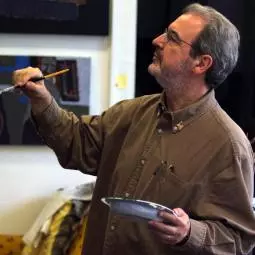Biography
There are some fixed points in Piero Toresella’s paintings.
The net, which is a sort of personal signature of his works, with a large mesh web which contains, marks and almost denies the painting behind it.
The ambiguity, the possibility of multiple interpretations unresolved.
The Anti-contemporary, which, though it may sound like a condemnation of the present day, actually sounds like - if you take the dash out, and here is one ambivalence, the adjective ‘antique’ prefixed to the word ‘contemporary’. Therefore, it includes history in contemporaneity, setting the continuum of time free from an illogical partition.
It reflects Jean Clair’s idea, who thinks that every museum which is specialized in medieval, renaissance or modern art actually breaks the flowing, uninterrupted course of time. If not sustained by the essential substrate of history, contemporary art does not exist.
A non-painting painting. This means that his art denies and moves away from the main traits of painting as it is traditionally intended, such as the Venetian and Spanish schools or the impressionists, that is a painting made of blended color, which focuses on the surrounding world and its atmosphere through chromatic vibrations and visible brush strokes. On the contrary, his painting is smooth and softens the matter's impulse; every surface appears compact, with no blur, in a dry sharpness that is almost unnatural due to the precise definition of its chiaroscuro. He withdraws color. His painting is essentially black and white, constantly aiming at a restrained expression, which renounces pleasant surfaces, in favour of an urgent conceptual content. His art is actually conceptual.
The constant use of photography as a reference point from which images are born and as a mechanical filter between reality and the pictured imaginary.
The artifice, expressed in the cycle ‘Vanitas’, where the dummy, an inert semblance, replaces the human being.
 Share / Save
Share / Save





